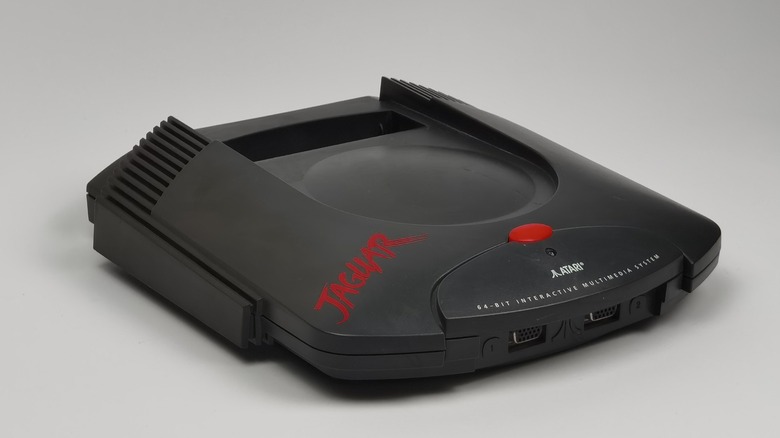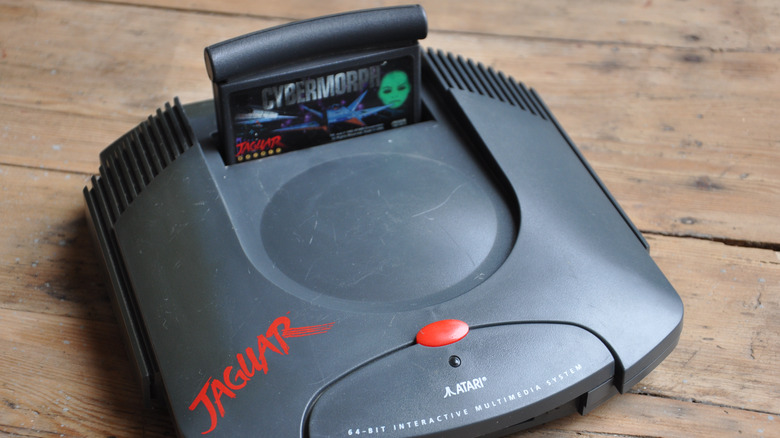Here's How Much An Atari Jaguar Is Worth Today
The Atari Jaguar went on sale on a limited basis in New York City in November of 1993, with a nationwide rollout following six months later. The timing coincided with the start of the "fifth generation" of video game consoles, an era that began in 1993 and lasted until 2001. On shelves at the time were long-in-the-tooth fourth-gen 16-bit machines like the Sega Genesis (released in August 1989) and the Super NES (released in August 1991).
While The 3DO Company did release its 32-bit Interactive Multiplayer rig at the beginning of October '93, it had a shell-shocking price tag of $699. Sony's first PlayStation wouldn't drop in Japan for another year (December 1994) and was still almost two years out (September 1995) from hitting American shores. With a much lower MSRP of $249, Atari was ideally situated to let the sleek 64-bit Jaguar out of its cage and run wild. Instead, it became the last console the company would make. At least until the VCS arrived a few decades later.
Given the cyclical nature of our world, if you hold on to something long enough, it will eventually be worth something to someone somewhere. Such is the case with the Jaguar, which has recently become one of the more sought-after retro consoles. Depending on the condition, accessories, and bundled games, the value of this beast has leaped into quadruple original selling price territory.
Get bit by Jaguar
The 64-bit feature was Jaguar's big selling point. Except, it really wasn't 64-bit. Oh sure, the math kind of added up, but in reality not so much. Atari claimed the Jaguar, like its animal namesake, ran circles around the competition because it had a proprietary 64-bit RISC processor — the first of its kind. Additionally, it boasted that it ran 16 million colors in 24-bit color graphics, bang out shaded 3D polygons "manipulated in a 'real' world in real-time" (whatever that means), and had real-time texture mapping.
The reality was that it ran five processors mounted on three chips. The "manager" was the hybrid 16-bit/32-bit Motorola 68000, which was, in fact, a 32-bit processor but only used a 24-bit address and 16-bit data lines. The two other chips (both 32-bit) had different jobs. "Tom" was the GPU, object processor, and blitter (among other things). "Jerry" handled digital signal processing and 16-bit CD-quality stereo sound.
Atari's 64-bit kludge aside, the game was bereft of a powerhouse library or original must-have games, and many were just poorly done ports of other games. Thus the graphics jump Atari promised wasn't really there. Even a CD add-on peripheral (released two full years after its initial launch) and the promise of a VR headset (which never came to fruition) couldn't bolster sales. Ultimately, nothing about the console made consumers feel like they had to "Get bit by Jaguar," a genuinely ironic marketing slogan.
Catch it if you can
Despite all that, here we are 30 years later talking about the Jaguar, proving the old adage that everything that was once old eventually becomes "new" again. Thanks to console collectors, who finally appear to have been "bit," Atari's "64-bit" powerhouse has been lifted back into relevance.
As recently as May 2023, a "new" system sold for $999.99, while another "new" and "sealed" Jaguar sold in April for an astonishing $1,199.99. Currently, multiple eBay listings covering a wide range of price points exist. Two are up for grabs at $685 (with or without a game), another at $800, and one is tagged at $950. Several others are neatly nestled down in the $400 and $500 range. There's even an Amazon entry that includes the console, a controller, and two games for "only" $1,499.99.
With prices scattered all over the map, now might be a good time to catch a Jaguar by the tail. But keep another old proverb in mind: caveat emptor. Or "let the buyer beware" for those who don't speak Latin.


